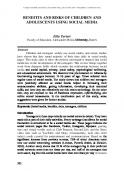ALSAR Assessment of Living Skills and Resources
This document was submitted by our user and they confirm that they have the consent to share it. Assuming that you are writer or own the copyright of this document, report to us by using this DMCA report button.
ALSAR summary prepared by the Occupational Therapy Program, University of Western Sydney Funded by the Motor Accidents Authority of NSW, May 2006
1
task is defined as ‘low’ (combined score of 0 or 1), ‘moderate’ (combined score of 3) or ‘high’ (combined score of 4). The 11 risk scores are summed to provide an “R” or Total Risk Score, indicating the risk of overall negative outcomes for the client. An “R” score over 20 indicates a moderate risk, over 30, a high risk. Scoring Time: Approximately 30 minutes. Population Groups: People over 60 years of age. Languages: The ALSAR is available in English only. References: Connor-Spady, B., Slaughter, S., & MacLean, S. (1999). Assessing the usefulness of the Assessment of Living Skills and Resources (ALSAR) in a geriatric day hospital. Canadian Journal of Rehabilitation, 12(4), 265 – 272. Drinka, T.J.K., Williams, J., Schram, M., Farrell-Holtan, J., & Euhardy, M. (2000). Assessment of Living Skills and Resources (ALSAR©), an instrumental activities of daily living assessment instrument (pp. 726-9). In D. Osterweil, K. BrummelSmith & J Beck (Eds.). Comprehensive Geriatric Assessment. New York: McGraw-Hill. Fricke, J. (1997). Training Manual for ALSAR, Assessment of Living Skills and Resources. Melbourne: La Trobe University. Neistadt, M.E. (2000). Occupational therapy evaluation for adults. Baltimore, Maryland: Lippincott Williams & Wilkins. Williams, J., Drinka, T., Greenberg, J. Farrell-Holtan, J., Euhardy, R., & Schram, P. (1991). Development and testing of the Assessment of Living Skills and Resources (ALSAR) in elderly community-dwelling veterans. The Gerontologist, 31(1), 84-91.
ALSAR summary prepared by the Occupational Therapy Program, University of Western Sydney Funded by the Motor Accidents Authority of NSW, May 2006
2
ICF Levels: Level Addressed by Measure
Yes
No √
Body Function/ Structure Activity
√
Participation
√
Psychometric Properties: Published Data Available for the Measure
Yes
No
Validity Face Content1, 2 Criterion1, 2 Construct1
√ √ √
√
Reliability Test – retest Intra – rater Inter – rater1, 2 Other information available Responsiveness to change 3 Standardised4 Clinically important change Clinical utility3
1. 2. 3. 4.
√ √ √
√ √
√
√
Williams et al (1991) Data summarised in Neistadt (2000) Connor-Spady et al (1999) Fricke (1997)
ALSAR summary prepared by the Occupational Therapy Program, University of Western Sydney Funded by the Motor Accidents Authority of NSW, May 2006
3

Related documents
3 Pages • 750 Words • PDF • 170.9 KB
8 Pages • 4,572 Words • PDF • 154.1 KB
9 Pages • 4,158 Words • PDF • 75.9 KB
12 Pages • 4,408 Words • PDF • 201.2 KB
2 Pages • 801 Words • PDF • 371.1 KB
1,094 Pages • 709,071 Words • PDF • 18.6 MB
532 Pages • 150,537 Words • PDF • 20.9 MB
19 Pages • 4,197 Words • PDF • 2.2 MB
1 Pages • 115 Words • PDF • 560.7 KB
16 Pages • 7,313 Words • PDF • 455 KB
237 Pages • 54,663 Words • PDF • 8.5 MB
27 Pages • 527 Words • PDF • 2.2 MB











